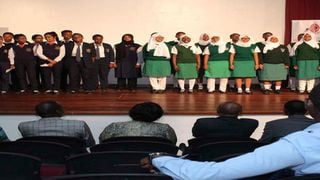
Students of Arya Secondary School, Ngara Girls and Matuga Girls High School recite the national anthem translated in Sheng and Digo dialect during the Safer Internet Day at Louise Leakey Auditorium, National Museums of Kenya in Nairobi on February 7, 2017.
| File | Nation Media GroupWeekend
Premium
Don’t blame Sheng for poor results in Kiswahili exams
What you need to know:
- There has been a contradictory performance in English and Kiswahili in the coast region.
- Lamentations over poor performance in Kiswahili among candidates from the Coast are not a new phenomenon in Kenya.
Recently, I read in the local media about the concern of leaders and education officials in Mombasa over the county’s ‘dismal performance’ in Kiswahili in the Kenya Certificate of Primary Education (KCPE) last year.
The leaders, who spoke at a meeting held at Mvita sub-county, after reviewing the county’s performance over the years, lamented that while Mombasa was the ‘headquarters’ of Kiswahili, it was worrying that many candidates from that region had been failing in the subject.
Some speakers in the meeting are said to have blamed the emergence of two slangs - Sheng (Swahili + English) and Engsh (English + Kiswahili) for the poor performance in Kiswahili KCPE results.
The meeting, chaired by Member of Parliament Abdulswamad Nassir, observed that Mvita sub-county posted the most unimpressive Kiswahili KCPE result. The sub-county, which covers the entire Mombasa island, has 72 primary schools. However, it was noted that English was the best performed subject in the sub-county.
The contradictory performance in both Kiswahili and English cajoled me to interrogate the claim that the slangs - Sheng and Engsh are to blame for the poor performance in Kiswahili – not only at the coastal region, but also in other parts of the country.
Kiswahili dialects
Lamentations over poor performance in Kiswahili among candidates from the Coast are not a new phenomenon in Kenya. In 2008, for example, poor results in the subject, compared with the performance of students from ‘bara’ (mainland) caused so much uproar when the Kenya Certificate of Secondary Education (KCSE ) results were announced.
Incensed with the results, renowned Swahili scholar – the late Mzee Ahmad Sheikh Nabhany – called upon the Kenya National Examinations Council (Knec) to consider setting Kiswahili exams in each of the 15 or so dialects. His argument then, was that candidates from the Coast – majority of whom speak various Kiswahili dialects were being ‘shortchanged’ in sitting an exam that was set in standardized Kiswahili or Kiswahili Sanifu. The scholar, who passed on in 2017, however did not factor in the cost implications of developing the 15 dialects that make up Kiswahili. The original or native Waswahili are the Wangozi.
Kiswahili is a conglomerate of about 15 dialects, namely: Kiunguja (Zanzibar), Kimakunduchi (or Kihadimu) and Kitumbatu (spoken in rural parts of Zanzibar), Kipemba (Pemba island); Kimtang'ata (Tanga); Kimrima (Coast of Tanzania) and Kimgao (Kilwa).
Others are: Kimvita, Kingare, and Kijomvu (Mombasa island and environs); Kiamu, Kisiu, Kipate, Kibarawa (Kimiini), and Kitikuu (along the coast of northern Kenya into southern Somalia), Kivumba and Chichifundi (Wasini and Vanga), Kingwana (DRC and Congo) and Kingozi (original Kiswahili).
Kiunguja was selected by missionaries to be the basis of standardising Kiswahili. Kiunguja outcompeted Kimvita dialect which was also being considered for the standardization exercise. One major reason of favoring Kiunguja over Kimvita and other dialects was that it was widely used in trade and had a substantial amount of written corpus.
What is taught in our school system right from primary – through secondary schools to tertiary institutions is standard Kiswahili (Kiswahili Sanifu). Sociolinguists agree that dialects of any language are mutually intelligible - differing only in certain phonological and lexical features. Due to this fact, we expect students from the Coast to have an added advantage in learning, speaking and writing Kiswahili because their dialects don’t differ much from standard Kiswahili.
poor performance
Claims that poor performance in Kiswahili examinations by students from the Coast are as a result of Sheng and Engsh are hogwash due to the following reasons. One, Sheng and Engsh are not taught in our education system.
Since the language code (Sheng) emerged among the youth living in slum areas of Nairobi in the 1930s, it is over seven decades. This is rather a very long period for language teachers not to have come up with measures to counter the effects (if any) of Sheng in examination performances. Two, we have a sociolinguistics course taught at all levels of education — in which learners are guided on the boundaries of language use. In the course, referred to as Isimujamii, learners are taught when, how and where to use Kiswahili Sanifu.
Three, slangs are not only unique phenomenon in East Africa. They are a commonplace even in England, where the Queen’s English is spoken.
In my view, poor performance in languages – among students emanates from the erroneous notion that Kiswahili and English subjects are easy and therefore a walkover in examination encounters. The poor performance of Coastal students in Kiswahili – which otherwise is their ‘(m)other tongue should ring a bell in their minds that language is not as simple as they may think.
The effort applied in studying science subjects such as physics, chemistry and biology should also be employed in studying Kiswahili and English.
Enock Matundura, translator of Barbara Kimenye’s Moses Series (Oxford University Press), teaches Kiswahili literature at Chuka University. [email protected]




